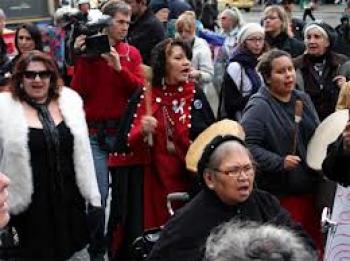In the early 1970’s with the concept of Aboriginal Rights gaining profile in the national discourse, Indigenous women began to challenge the provisions of the Indian Act that striped them of their identity as Indigenous people. A series of legal challenges to the legislation were launched. In 1971 Jeannette Corbiere Lavell and Yvonne Bedard launched separate a court challenge against the Act charging that the provision that striped women who married non-indigenous men of their identities and their status as Indians was in violation of the equality clause under in the Canadian Bill of Rights (1960). In 1973 the Bedard and Lavell cases were joined when they before the Supreme Court. There their initial victories were struck down and the previsions that stripped Indigenous women of their communities and identities were upheld.
From 1973 onward Indigenous Women and their allies organized, forcing the Canadian public, Canadian government and even the Reserve Band Councils to recognize the oppression Indigenous women faced both as Indigenous people and as women. Equal Rights for Indian Women, founded by Mary Two Axe Early, a Mohawk Woman from Kanawake, in conjunction with the National Native Women’s Associations and with the help of some allies as such as the National Action Committee on the Status of Women conducted sit-ins, marches across the country. The Aboriginal Women’s Walk from Oka to Ottawa in particular brought the fight to greater public prominence.
It was however it was the case of Sandra Lovelace a Maliseet woman from Tobique in New Brunswick who was denied access to her home community after the breakdown of her marriage to a non-indigenous man that really sparked a change in policy. Like Laval and Bedard, she had taken her challenge of the Indian Act the to the Supreme Court. Once again the Court upheld the Act. Sandra Lovelace then took her case before the UN Human Rights Committee. The Canadian government was denounced for its treatment of Indigenous women and in 1981,was found to be breach of the International Covenant on Civil and Political Rights. It took this international shaming to force the Canadian government to take rectify this gave injustice. In 1985 Bill C-31 was passed which revised the Indian Act to bring it into accordance with the Canadian Charter of Rights and Freedoms.
As a result over 127, 000 Indigenous people who had previously been denied Status immediately regained it. The amendments however contained a second generation cutoff which means that only the children of two status people will be able to pass on status to their own children.




